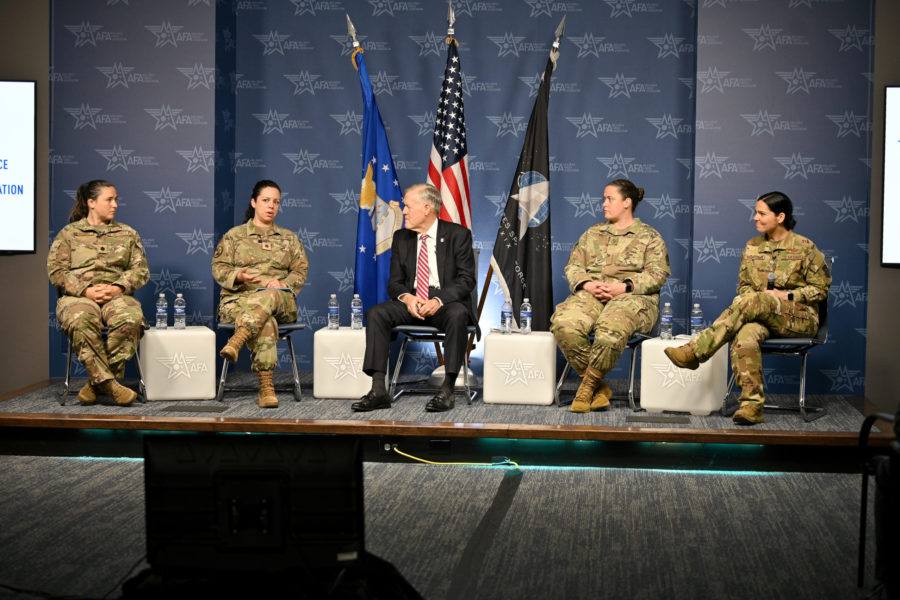Members of Air Force Special Operations Command face plenty of challenges and discomfort. “They’re on the ground, they’re living in cots, they’re flying the aircraft, they’re on missions anywhere from 16 to 18 hours long,” Lt. Col. Meghan O’Rourke, AFSOC’s mobility requirements branch chief and an MC-130 combat systems operator. “It’s a demanding schedule for my air commandos out there.”
O’Rourke was among four women Airmen, all members of Air Force teams focused on cutting through factors that limit women’s mission effectiveness to join an AFA Warfighters in Action online video discussion June 9. “I don’t want them worrying about their families back home,” O’Rourke said. “I don’t want them worrying about personal hygiene or anything like that. I want those barriers tackled. These are leadership issues, these aren’t women’s issues. These are leadership issues. I want those tackled so that they can do their job as well as they possibly can.”
The Department of the Air Force’s Women’s Initiatives Team leads department-wide efforts to remove those barriers. But at the major command level, “Athena” teams—named for the mythical Greek goddess Athena, the goddess of war—have formed to take on issues at the operational level.
The first Athena team appeared in 2019 at Air Combat Command, Maj. Sharon Arana said, led by Col. Rebecca Lange to focus on ACC-specific issues. From there, the idea spread “like wildfire” to other major commands, each with a slightly different name: AFSOC’s is Dagger Athena, ACC’s is Sword Athena, and ARC (Air Reserve Component) Athena represents both the Guard and Reserve, among others.
The focus, Arana said: “Make us more lethal and ready to do our jobs and execute our mission.”
With more than one-fifth of Active-Duty Airmen being women, the Air Force can ill afford not to address these issues, Athena team members said. That’s especially true as the service pursues concepts like Agile Combat Employment (ACE), where small teams of Airmen may need to operate from remote or austere bases for weeks at a time. In such scenarios, leaders will have to account for different needs to ensure their Airmen are positioned to perform.
“For us at the Sword Athena level, we just look at, ‘Hey, how do we make this weapon system of the Airman more lethal?’” said CMSgt. Diana M. Scaramouche, the senior enlisted leader of the personnel division at ACC. “Take care of the basic physiological needs: toilet paper, pads, and tampons; female fitment equipment for the officer flyers, as well as the enlisted side. How do we come together to make sure that we’re all taken care of. And I think it makes us even more lethal. Because when you look at China, I don’t think they’re considering that.”
Female fitment is crucial, because without gear designed for women, whether that’s body armor to support for basic human necessities, they can’t expect to be at their best.
“If we talk about tactical dehydration, we know that happens male and female. So tactical dehydration is when you don’t drink maybe five to eight hours prior to step,” said SMSgt. Rebecca Schatzman, a squadron enlisted leader and C-17 loadmaster. “So when you get in the aircraft, your cognitive response goes way down. Your pass-out rate goes way up. That is not what we need in the next fight. We talk about equipment and resources—we know that there’s equipment out there, bladder relief devices, female flight suits … any kind of female equipment, we need those resources.”
In recent years, the Air Force has started testing out new technology for bladder relief, and ACC’s Sword Athena team is working to make sure that equipment can get to everyone who needs it.
“So there’s the funding aspect, in order for them to be accessible, and where does that come from?” Arana said. “How do you coordinate this as well? How does a unit determine how many of each kit to fund and to carry? One of our initiatives at Sword Athena is to stand up a cross functional team, and the attempt is to collect all of the requirements for female fitment writ large, but it’s driven because of female bladder relief.”
While getting such equipment does require funding, the Air Force should weigh the cost against the risk it runs by not giving female Airmen what they need to be successful, the panelists said.
“I will quote [National Guard chief Gen. Daniel Hokanson] on this one—at ARC Athena, he stated that ‘Women are not little men,’” Schatzman said. “That’s one big piece, and it kind of sums it up as a whole, when we talk about equipment and specialized equipment. It really shouldn’t be specialized equipment. It should just be equipment. There is no one-size-fits-all.”
For years, the Air Force—along with other parts of the military—designed equipment based on men and their body types, from uniform cuts to the dimensions of cockpits.
But as the demographics of the force continue to change, so too are the baseline design requirements. Just next week, O’Rourke noted, the Air Force Uniform Office is traveling to Eglin Air Force Base, Fla., for design and fit testing for some changes to the Operational Camouflage Pattern (OCP) uniform. Specifically, the office is recruiting 200 female Airmen and 100 male Airmen to take part, O’Rourke said.
“That’s just one example where we’ve got a lot of data out there from the decades that we’ve been fighting of what the male body looks like, but now, how do we incorporate all the different female types and sizes and movement abilities?” she said. “I know the Air Force office is looking at this very, very deeply at this point to make sure we’re tackling some of these problems and getting that data that frankly is just lacking right now.”
Fitment is just one area that Athena teams are tackling—panelists also highlighted issues with child care, health care, and recruiting that they’re looking into.
